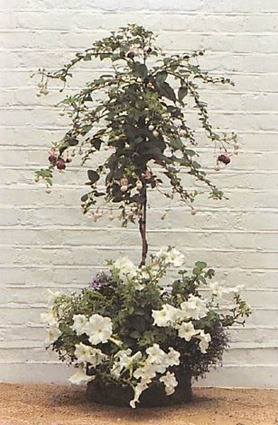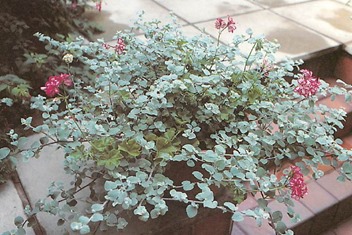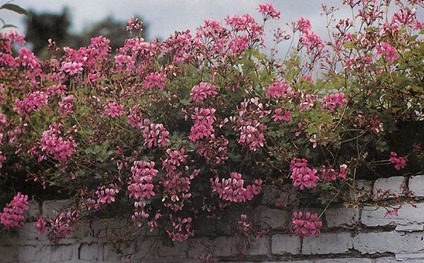





The Advantage of Tubs
In a garden where you wish work to be cut down to the minimum, tubs are ideal. If low-maintenance planting is successful there will be no room in the beds between the permanent ground cover, plants and shrubs to plant annuals. Summer colour can be provided with summer bedding in the tubs which will be far less trouble.
Pots and tubs also help vary the height of interest and colour in the garden, added to which it is easy to replace the soil, feed, water and plant tubs. Tubs give so much value for comparatively little work, but they do need watering regularly in the summer, even more so if they are in positions where they will not get the rain such a: under the eaves of the roof or the canopies of large trees. Even in winter tubs in this situation should be watered once a week, although tubs that get the rain may only need watering every so often.
One frequently notices dead bay trees in tubs outside town house front doors; this is not usually due to a cold winter or even a too-small tub, but mainly to lack of water.
If you want to plant a tub, urn or pot up from scratch, the most important ingredients are good potting compost with good drainage (or the soil will become waterlogged) and healthy plants. Once you have chosen your container, if it is more than 2 ft (60 cm) in diameter, put in a 2-3 in (5-7.5 cm) layer of gravel, stones or crocks at the bottom of the tub for drainage, and then add John Innes Potting Compost No. 3 except for rhododendrons and camellias. They need lime-free compost and should be planted in Ericacious compost (from garden centres).
The containers, whether they are tubs or pots, look more attractive if you choose a large plant as a focal point for the middle. Evergreens such as dwarf conifer, Yucca filamentosa, cordyline, camellia or small bay trees are all perfect choices. Cordyline needs a warm sheltered spot and should be tied up in November to protect its ‘heart’ from frost during the winter months.
Container – all containers must have drainage holes at the bottom of the tubs so the roots don’t get waterlogged.
Gravel or broken crocks
Trowel
John Innes Potting Compost No: 3 or Ericacious compost for camellias and rhododendrons
John Innes Potting Compost No. 2 for small plants in small pots
Secateurs (to cut back damaged or withered growth)
Gloves
Watering Can
 The average tub will need a focal plant for the middle, any of the plants mentioned earlier, which should be at least 1-3ft (30-90cm) taller than the other plants. Then four variegated ivy plants for round the edge, and four grey-leafed plants such as Senecio bicolour ‘Silver Dust’, to make up an elegant year-round container which will need no more than feeding in spring and watering during the summer. A small pot of say 18 in (45 cm) will need a plant in the middle that is about 10 in (25 cm) higher than the others. But in a 3 ft (90 cm) container, the central plant can be anything from 2 ft to 4 ft (60-120 cm) higher than the surrounding plants.
The average tub will need a focal plant for the middle, any of the plants mentioned earlier, which should be at least 1-3ft (30-90cm) taller than the other plants. Then four variegated ivy plants for round the edge, and four grey-leafed plants such as Senecio bicolour ‘Silver Dust’, to make up an elegant year-round container which will need no more than feeding in spring and watering during the summer. A small pot of say 18 in (45 cm) will need a plant in the middle that is about 10 in (25 cm) higher than the others. But in a 3 ft (90 cm) container, the central plant can be anything from 2 ft to 4 ft (60-120 cm) higher than the surrounding plants.
Evergreens such as rhododendrons, camellias, bay and ivy need water during the winter, so remember to water them all year round. If you wish to add seasonal colour, plants such as geraniums and petunias can be added in May and pulled out in December, and you can underplant with grape hyacinths, miniature tulips and miniature daffodils for colour in the early spring.
Pansies will go on flowering throughout the seasons; they are an excellent, reliable, if familiar, stand by, and will continue from one year to the next. They are particularly attractive if you select all one colour.
Once you have the basis of the container (a tall plant in the centre and ivy trailing over the edge) you can add as many geraniums, hostas (half-hardy for semi-shade), nasturtiums, oxeye daisy, Senecio cineraria (full sun), chlorophytum (spider plants), petunias, fuchsias, Lobelia evinus, Michaelmas daisies, Tolmiea menziesii (pig-a-back), white alyssum, Lobularia mantina, Busy Lizzie, miniature roses, feverfew, asparagus ferns, tobacco plants, campanula, Alchemilla mollis (ladies’ mantle) and Helichrysum petiolatum as your heart desires or you have room for. But a few plants carefully selected for their colour are sometimes more impressive.
The hard edges of the containers are best broken up by trailing plants such as variegated ivy, which is also a good camouflage for the sides of an ugly tub. Ivy can be rather expensive, but it is easily propagated and if you buy one or two plants these will soon put out new shoots, and this new growth plus the new root tentacles should be cut off and put into a glass of water. After a few weeks, plant the cutting in moist peat. You should soon produce enough ivy to trail over the sides of half a dozen containers! But you have to be patient as it takes time to get established. Ivy sold as house plants is much cheaper and perfectly suitable for using in the garden.
Mature ivy roots can be a bit ‘pushy’ so you need to cut down through the ivy root system with your trowel every year or two to break the root system so that other plants’ roots have a chance.
 Colour is a question of taste. I prefer variegated ivy, grey foliage such as Helichrysum and a pink trailing ivy leaf geranium called ‘King of the Balkans’ which has a continuous show of masses of delicate bright pink flowers. Coupled with white campanula, this makes a quiet pleasant display. An all grey and white arrangement of Senecio bicolour ‘Silver Dust’, white petunias (which need plenty of water), Helichrysum and white campanulas is very smart.
Colour is a question of taste. I prefer variegated ivy, grey foliage such as Helichrysum and a pink trailing ivy leaf geranium called ‘King of the Balkans’ which has a continuous show of masses of delicate bright pink flowers. Coupled with white campanula, this makes a quiet pleasant display. An all grey and white arrangement of Senecio bicolour ‘Silver Dust’, white petunias (which need plenty of water), Helichrysum and white campanulas is very smart.
But I have seen many dazzling patios, small gardens or balconies filled with every colour under the sun. As I said, it is just a question of your own preference. There are no rules and some of the most unlikely combinations take on a new charm when put together. Even plants I don’t really like, such as marigolds, can look pretty in the right setting. But the rule tends to be, in the country colourful displays are more in keeping and in towns the quieter more select choice is preferable.
 Remember once your tub is planted up to water daily during the summer, and feed the plants a liquid manure such as Bio plant food in the watering can once a week, or you can use a good feed in spring with a slow release fertiliser. But most important, water well at least three times a week, as containers dry out quickly, especially in full sun. Rain tends not to soak into the earth; usually it just moistens the surface as it splashes off the leaves. So a good soaking with a hose is vital.
Remember once your tub is planted up to water daily during the summer, and feed the plants a liquid manure such as Bio plant food in the watering can once a week, or you can use a good feed in spring with a slow release fertiliser. But most important, water well at least three times a week, as containers dry out quickly, especially in full sun. Rain tends not to soak into the earth; usually it just moistens the surface as it splashes off the leaves. So a good soaking with a hose is vital.
If you go away, take the containers out of the sun and leave them grouped together near a few buckets of water, so there is moisture in the air around them. Before leaving, drench the containers thoroughly, then pack moist peat, moss or bark chips over the soil to retain the moisture. Otherwise ask your neighbour to water them with the hose over the garden fence.
You could buy a timer cap. The simplest ones are Hozelock ASL Aquameter Water Controller and Garden Watertimer. Both turn the water off after a fixed time. They do need to be reset each day, but nevertheless they will save your neighbour a lot of time and hard work.
Copyright © www.100flowers.win Botanic Garden All Rights Reserved